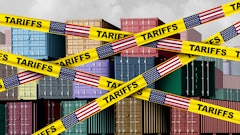
On the day President Trump ended the de minimis exemption, U.S.-bound shipments fell 81%. The sharp decline underscored how central the exemption had become to global trade and how reliant businesses and consumers had grown on its simplicity.
For years, the policy allowed low-value goods under $800 per shipment to enter the United States without tariffs and with minimal paperwork. It reduced administrative burdens for small parcels, streamlined customs processing and supported rapid growth in e-commerce. Shoppers benefited from lower costs and faster delivery, while international sellers could reach U.S. consumers without navigating complex import regulations.
At the same time, the exemption created openings for tariff evasion and illicit shipments, including counterfeit products and undeclared drugs.
Closing the loophole was framed as an enforcement measure aimed at making tariffs effective and reducing opportunities for abuse. The result has been immediate disruption across ports, supply chains and consumer markets, affecting everything from delivery timelines to product availability.
Ports under pressure
The end of the exemption has shifted millions of small parcels into the full customs system. Every shipment now requires documentation, tariff classification and in many cases, physical inspection. Even with volumes reduced, processing takes longer and costs more.
Until February 2026, shipments can enter the country with a temporary flat rate; after that, full ad valorem tariffs will apply. This transition means higher administrative burdens and increased costs for shippers, further dampening demand. A cycle has emerged: even as volumes decline, processes have become less efficient, and more scrutiny slows throughput and creates backlogs.
Postal services in several countries have paused U.S.-bound small parcel deliveries, citing new requirements. At ports, cargo is moving more slowly. What once moved quickly under de minimis is now a chokepoint, where enforcement meets logistics.
Consumers shoulder the cost
The policy shift is translating directly into a downgraded consumer experience. For households, this means higher costs on everyday goods, from electronics and accessories to clothing and small home items, as well as longer wait times for delivery. The impact comes at a moment when consumer confidence is already fragile and shoppers are more cautious about discretionary spending. Since consumer spending accounts for nearly 70% of the U.S. economy, even small increases in cost or added friction in the purchasing process can have broader implications.
Ending de minimis is unlikely to trigger an economic downturn on its own, but it adds another layer to existing pressures, including inflation, supply chain instability and rising interest rates. The cumulative effect can dampen spending behavior, even for relatively low-cost items and may slow overall economic activity as households adjust their budgets in response to higher prices and delayed deliveries.
The global ripple effect
The consequences extend well beyond U.S. borders. International logistics networks are restructuring as shippers pivot from small parcels to bulk containerized imports, adding complexity and further delays.
Countries that leaned heavily on de minimis-driven e-commerce, particularly China, were hardest hit. Online marketplace platforms had scaled their models around the exemption, technically within the rules but contrary to the spirit of tariff enforcement. This business model essentially collapsed overnight.
The bigger picture is for nations as a whole. The decision to end the de minimis exemption represents a broader shift in U.S. trade policy to encourage domestic production at the expense of imports, even if it limits consumer choice and slows economic growth.
Small businesses caught in the middle
For small businesses, the fallout is particularly acute. Overseas entrepreneurs, including those in Canada and Mexico, now face steeper barriers to entering the U.S. market. Unlike large corporations, many smaller companies lack the resources to navigate complex customs filings and may abandon U.S. sales altogether.
The loss is not just theirs. U.S. consumers lose access to niche and boutique products that differentiate small sellers from larger retailers. Domestic small businesses are also affected. Many relied on de minimis for importing raw materials or specialty goods that supported thin-margin operations. When input costs rise by double digits, small firms face hard decisions about whether to continue producing certain items or exit the market altogether.
Balancing enforcement and impact
The official rationale for ending de minimis focused on curbing tariff evasion and illicit shipments. In practice, the trafficking angle was secondary; the central issue was that punitive tariffs lose effectiveness if importers can bypass them by breaking shipments into smaller parcels. Removing the exemption gives trade policy more bite.
There are potential upsides. Domestic manufacturers may see reduced competition from low-cost imports, creating openings for local production. Counterfeit and undeclared goods will be harder to slip through, strengthening consumer safety and enforcement integrity. Over time, stricter oversight could build a more level playing field for compliant businesses.
Yet the immediate picture is mixed. Consumers face higher costs and longer delivery times. Small businesses, both abroad and at home, are absorbing the shock with limited capacity to adapt. Ports and postal systems are under strain as they adjust to new requirements.
The policy reflects a clear trade-off: stronger enforcement of tariff policy at the expense of efficiency and accessibility. For some, that means new opportunities. For many others, it means fewer choices, higher prices and another knock to already cautious consumer sentiment.


















